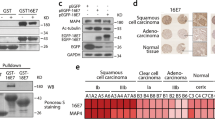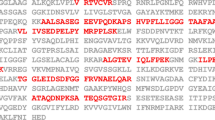Abstract
Human papillomavirus (HPV) encoded E7 oncoprotein plays an important role in supporting the viral productive cycle and inducing cancer phenotypes. The ability of E7 to exercise these functions, partly, depends upon its steady-state level. HPV manipulates the host de-ubiquitination pathway to maintain the stability of its viral proteins. In this study, we uncovered that HPV interacts with the host ubiquitin specific protease 7 (USP7), a universal de-ubiquitinating enzyme, leading to the stabilization of E7 oncoprotein. We observed that HPV16E7 complexes with USP7 via the E7-CR3 domain, and this E7-USP7 complex exists predominantly in the nucleus. Our results showed that USP7 stabilizes and prolongs the half-life of HPV16E7 by antagonizing ubiquitination and proteasomal degradation. Consistently, when we inhibited USP7 activity using HBX 19818, HPV16E7 protein level was reduced and its turnover was increased. We also provide evidence that HBX 19818-induced USP7 inhibition can halt HPV-mediated carcinogenesis, including cell proliferation, invasion, migration and transformation. These findings indicate that USP7 plays an essential role in stabilizing E7. The specific and potent inhibitory effects of HBX 19818 on HPV-induced carcinogenesis provide a molecular insight, suggesting the potential of targeting USP7 as a new therapeutic approach for the treatment of HPV-associated cancers.







Similar content being viewed by others
Availability of data and materials
The data and materials will be available upon request.
References
Bosch FX et al (2002) The causal relation between human papillomavirus and cervical cancer. J Clin Pathol 55(4):244–265
Heidegger I, Borena W, Pichler R (2015) The role of human papilloma virus in urological malignancies. Anticancer Res 35(5):2513–2519
Van Doorslaer K et al (2017) The Papillomavirus Episteme: a major update to the papillomavirus sequence database. Nucleic Acids Res 45(D1):D499–D506
Smotkin D, Wettstein FO (1986) Transcription of human papillomavirus type 16 early genes in a cervical cancer and a cancer-derived cell line and identification of the E7 protein. Proc Natl Acad Sci USA 83(13):4680–4684
Phelps WC et al (1988) The human papillomavirus type 16 E7 gene encodes transactivation and transformation functions similar to those of adenovirus E1A. Cell 53(4):539–547
Scheffner M et al (1990) The E6 oncoprotein encoded by human papillomavirus types 16 and 18 promotes the degradation of p53. Cell 63(6):1129–1136
Niccoli S et al (2012) The Asian-American E6 variant protein of human papillomavirus 16 alone is sufficient to promote immortalization, transformation, and migration of primary human foreskin keratinocytes. J Virol 86(22):12384–12396
Pickart CM, Eddins MJ (2004) Ubiquitin: structures, functions, mechanisms. Biochim Biophys Acta 1695(1–3):55–72
Wang J et al (2001) Both Rb and E7 are regulated by the ubiquitin proteasome pathway in HPV-containing cervical tumor cells. Oncogene 20(34):4740–4749
Oh KJ et al (2004) The papillomavirus E7 oncoprotein is ubiquitinated by UbcH7 and Cullin 1- and Skp2-containing E3 ligase. J Virol 78(10):5338–5346
Komander D, Clague MJ, Urbe S (2009) Breaking the chains: structure and function of the deubiquitinases. Nat Rev Mol Cell Biol 10(8):550–563
Holowaty MN et al (2003) Protein interaction domains of the ubiquitin-specific protease, USP7/HAUSP. J Biol Chem 278(48):47753–47761
Holowaty MN et al (2003) Protein profiling with Epstein-Barr nuclear antigen-1 reveals an interaction with the herpesvirus-associated ubiquitin-specific protease HAUSP/USP7. J Biol Chem 278(32):29987–29994
Chavoshi S et al (2016) Identification of kaposi sarcoma herpesvirus (KSHV) vIRF1 protein as a novel interaction partner of human deubiquitinase USP7. J Biol Chem 291(12):6281–6291
Ching W et al (2013) A ubiquitin-specific protease possesses a decisive role for adenovirus replication and oncogene-mediated transformation. PLoS Pathog 9(3):e1003273
Lin CH, Chang HS, Yu WC (2008) USP11 stabilizes HPV-16E7 and further modulates the E7 biological activity. J Biol Chem 283(23):15681–15688
Poirson J et al (2017) Mapping the interactome of HPV E6 and E7 oncoproteins with the ubiquitin-proteasome system. FEBS J 284(19):3171–3201
Nininahazwe L et al (2021) The emerging nature of Ubiquitin-specific protease 7 (USP7): a new target in cancer therapy. Drug Discov Today 26(2):490–502
Wu C et al (2019) Short half-life of HPV16 E6 and E7 mRNAs sensitizes HPV16-positive tonsillar cancer cell line HN26 to DNA-damaging drugs. Int J Cancer 144(2):297–310
Barrow-Laing L, Chen W, Roman A (2010) Low- and high-risk human papillomavirus E7 proteins regulate p130 differently. Virology 400(2):233–239
Shubin AV et al (2016) Cytoplasmic vacuolization in cell death and survival. Oncotarget 7(34):55863–55889
Pim D et al (2005) Activation of the protein kinase B pathway by the HPV-16 E7 oncoprotein occurs through a mechanism involving interaction with PP2A. Oncogene 24(53):7830–7838
Menges CW et al (2006) Human papillomavirus type 16 E7 up-regulates AKT activity through the retinoblastoma protein. Cancer Res 66(11):5555–5559
Han R et al (2018) Influence of human papillomavirus E7 oncoprotein on maturation and function of plasmacytoid dendritic cells in vitro. Virol Sin 33(6):493–501
Canning M et al (2004) A RING finger ubiquitin ligase is protected from autocatalyzed ubiquitination and degradation by binding to ubiquitin-specific protease USP7. J Biol Chem 279(37):38160–38168
Saridakis V et al (2005) Structure of the p53 binding domain of HAUSP/USP7 bound to Epstein-Barr nuclear antigen 1 implications for EBV-mediated immortalization. Mol Cell 18(1):25–36
Su D et al (2018) Ubiquitin-specific protease 7 sustains DNA damage response and promotes cervical carcinogenesis. J Clin Invest 128(10):4280–4296
Roman A (2006) The human papillomavirus E7 protein shines a spotlight on the pRB family member, p130. Cell Cycle 5(6):567–568
Jones DL, Alani RM, Munger K (1997) The human papillomavirus E7 oncoprotein can uncouple cellular differentiation and proliferation in human keratinocytes by abrogating p21Cip1-mediated inhibition of cdk2. Genes Dev 11(16):2101–2111
Wang Q et al (2016) Stabilization of histone demethylase PHF8 by USP7 promotes breast carcinogenesis. J Clin Invest 126(6):2205–2220
Zhao GY et al (2015) USP7 overexpression predicts a poor prognosis in lung squamous cell carcinoma and large cell carcinoma. Tumour Biol 36(3):1721–1729
Colland F et al (2009) Small-molecule inhibitor of USP7/HAUSP ubiquitin protease stabilizes and activates p53 in cells. Mol Cancer Ther 8(8):2286–2295
Reverdy C et al (2012) Discovery of specific inhibitors of human USP7/HAUSP deubiquitinating enzyme. Chem Biol 19(4):467–477
Chauhan D et al (2012) A small molecule inhibitor of ubiquitin-specific protease-7 induces apoptosis in multiple myeloma cells and overcomes bortezomib resistance. Cancer Cell 22(3):345–358
Turnbull AP et al (2017) Molecular basis of USP7 inhibition by selective small-molecule inhibitors. Nature 550(7677):481–486
Kategaya L et al (2017) USP7 small-molecule inhibitors interfere with ubiquitin binding. Nature 550(7677):534–538
Acknowledgements
We gratefully acknowledge Prof. Lawrence Banks and Dr. Miranda Thomas, International Centre for Genetic Engineering and Biotechnology, for generously providing us with the GST-E7 constructs, as well as editing this manuscript and giving us constructive comments. We also express sincere appreciation to Professor HUEN, Michael Shing Yan, University of Hong Kong, for the kind gift of the USP7 expression construct.
Funding
Not applicable.
Author information
Authors and Affiliations
Contributions
SSB and PKSC conceived and supervised the study. SSB and PKSC were involved in the conceptualization of the study. CCX performed experiments, collected data and analyzed results with help from CYX, HYL and SSB. CCX and SSB wrote the manuscript. All authors reviewed and edited the manuscript.
Corresponding author
Ethics declarations
Conflict of interest
Part of the findings of this study had been submitted for the U.S. Patent application (no. 18/333872).
Ethics approval and consent to participate
Not applicable.
Additional information
Publisher's Note
Springer Nature remains neutral with regard to jurisdictional claims in published maps and institutional affiliations.
Supplementary Information
Below is the link to the electronic supplementary material.
18_2023_4941_MOESM1_ESM.tif
Figure S1. The association between E7-encoded by HPV16 and USP7 in H1299 cells. A. Schematic diagram shows the alignment of amino acid sequences between HPV oncoproteins E6 and E7, plus EBNA1 from Epstein-Barr virus (EBV) and ICP0 from herpes simplex virus-1 (HSV-1), using Clustal Omega online tool (http://www.ebi.ac.uk/Tools/msa/clustalo/). The amino acid sequence 436 to 450 of EBNA-1 that is important for association with USP7, particularly the "PXE" motif (underlined), was found to align within HPV16-E6 at amino acids 12 to 14 (as highlighted by *), but not with HPV18-E6. Interestingly, the C-terminal ends of HPV-6 and HPV16-E7 (amino acids 94 to 97) appear to share close homology with amino acids 621 to 624 within ICP0 (as highlighted by *). B. Human non-small lung carcinoma cell lines, H1299 cells were either mock-transfected or transiently transfected with plasmids expressing Flag-tagged USP7 (FL-USP7) alone (+) or co-transfected with HA-tagged HPV16-E6 (HA-16 E6) (+) or -E7 (HA-16 E7) (+), as indicated. After 24 h, cell lysates were collected. HPV16-E6 and -E7 were immunoprecipitated using HA-conjugated agarose beads for 2 h at 4 °C. The samples were then subjected to SDS-PAGE and Western blotting to detect FL-USP7. The levels of HPV16-E6 and -E7 obtained by immunoprecipitation were ascertained using HA antibody and beta (β)-actin was included as a loading control. “-” indicates the relevant plasmid is not transfected. C. The levels of bound FL-USP7 or endogenous USP7 relative to their respective amount of input and precipitated E6 or E7 were quantitated from at least triplicates. Note that FL-USP7 (mean ± SD, p < 0.001) confers strong interaction with HA-16 E7 (TIF 17011 KB)
18_2023_4941_MOESM2_ESM.tif
Effect of HBX 19818 treatment on oncogenic signaling pathway. CaSki cells were treated with DMSO (a vehicle control) or HBX 19818 (3 μM or 6 μM) for 24 h. The total cell lysate was collected and analyzed by western blotting. The representative immunoblots show the levels of USP7, both phospho- and total AKT and ERK, Ras and HPV16E7 in CaSki cells. β-actin was included as a loading control (TIF 6524 KB)
18_2023_4941_MOESM3_ESM.tif
HBX 19818 destabilizes MDM2 and restores the p53 protein level. A. The representative immunoblotting images show the protein level of apoptotic pathways. CaSki cells were treated with DMSO or HBX 19818 (3 or 6 μM, as indicated) overnight. The protein level of p21, p53, MDM2, HPV16E7, USP7, caspase-3, -7 and -9 were examined via western blotting. B. The bar chart compares the relative protein level of MDM2 and p53 normalized by β-actin (n=3). Data are indicated as mean ± SEM. *p < 0.05; **p < 0.01 (TIF 11962 KB)
18_2023_4941_MOESM4_ESM.tif
USP7 co-localizes with HPV16E7 in the cell nucleus. Immunofluorescent images show the subcellular localization pattern of HPV16E7 and USP7. CaSki cells were incubated with anti-USP7 and anti-16E7 antibodies. Cellular localization of USP7 and E7 were visualized by fluorescent microscope under 1000x magnification (TIF 942 KB)
Rights and permissions
Springer Nature or its licensor (e.g. a society or other partner) holds exclusive rights to this article under a publishing agreement with the author(s) or other rightsholder(s); author self-archiving of the accepted manuscript version of this article is solely governed by the terms of such publishing agreement and applicable law.
About this article
Cite this article
Xia, C., Xiao, C., Luk, H.Y. et al. The ubiquitin specific protease 7 stabilizes HPV16E7 to promote HPV-mediated carcinogenesis. Cell. Mol. Life Sci. 80, 278 (2023). https://doi.org/10.1007/s00018-023-04941-2
Received:
Revised:
Accepted:
Published:
DOI: https://doi.org/10.1007/s00018-023-04941-2




